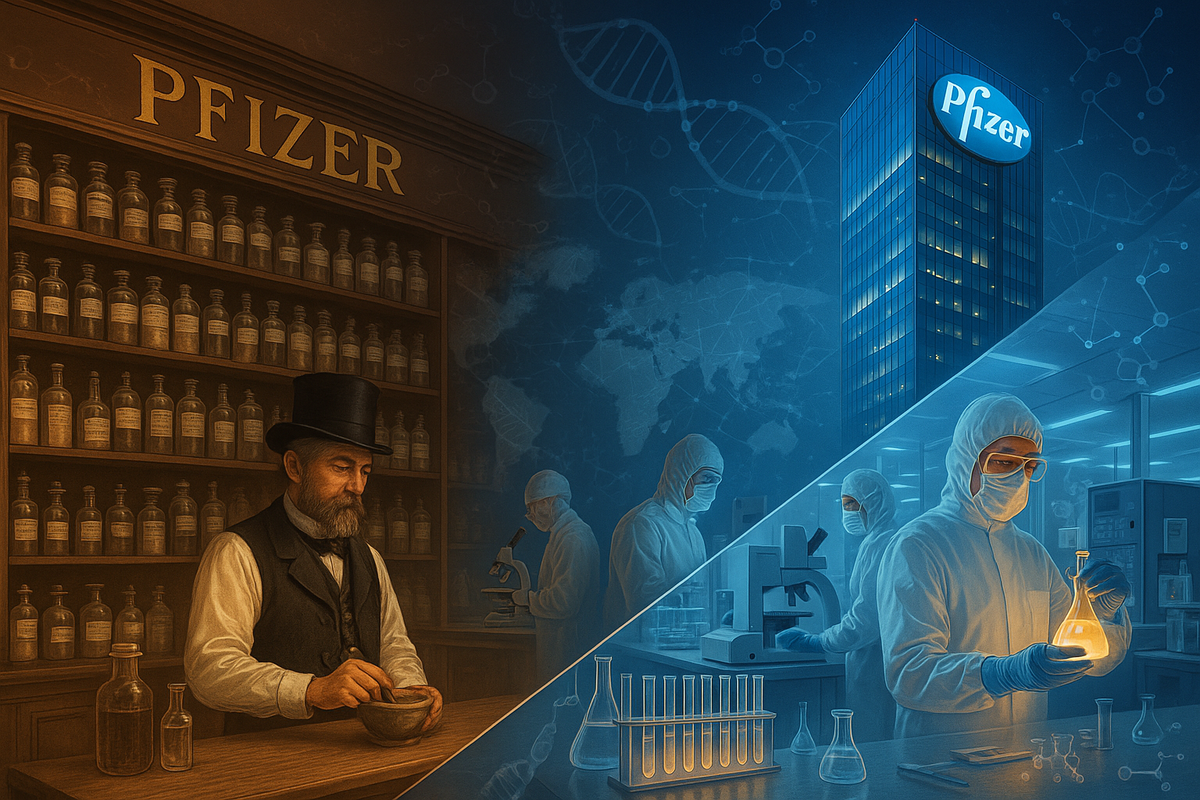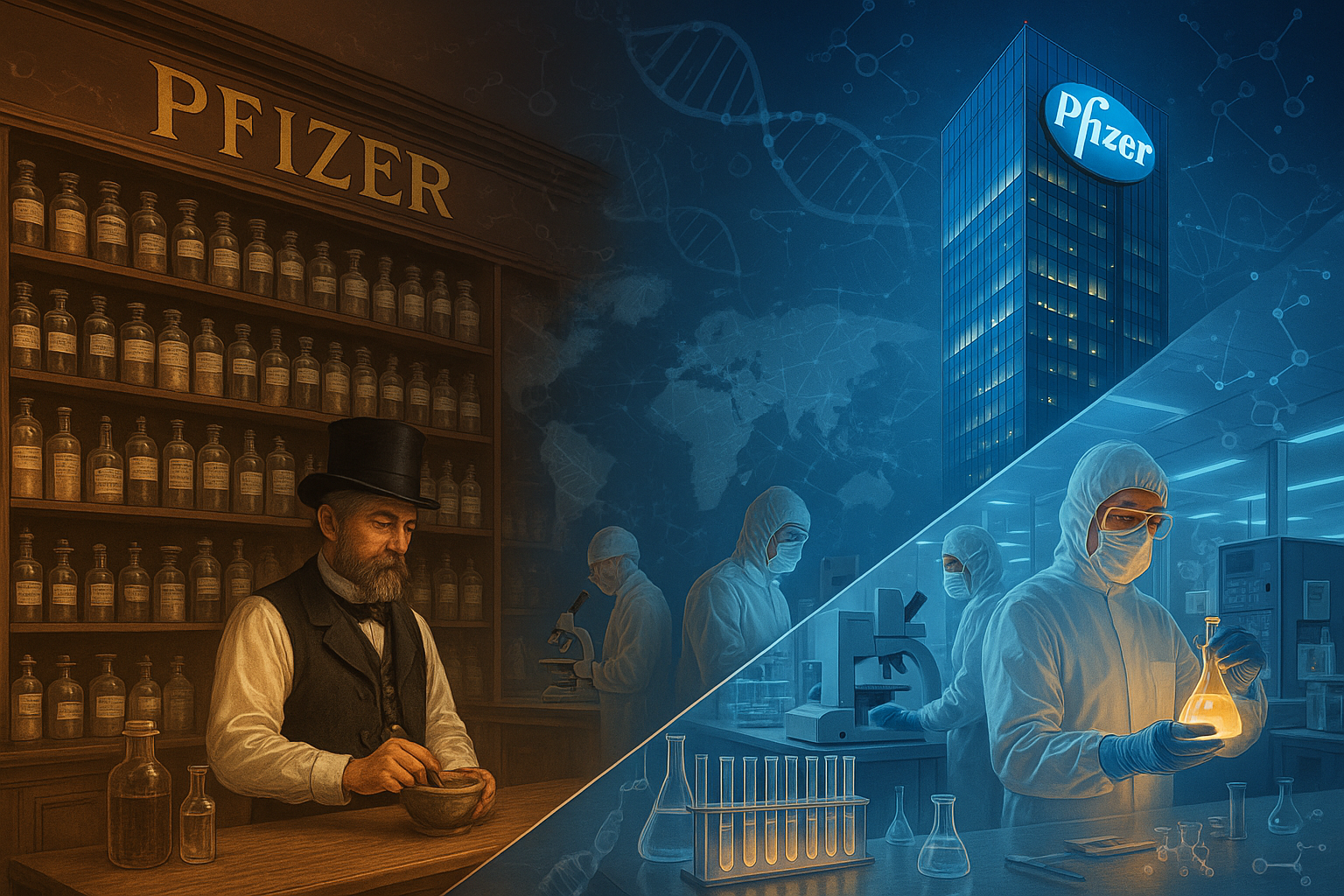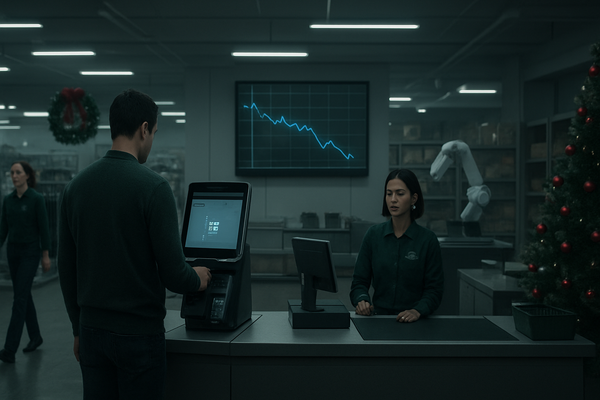From Apothecary to Global Powerhouse: The Enduring Legacy of Pfizer


Pfizer (NYSE: PFE), a name synonymous with pharmaceutical innovation and global health, stands as a testament to over 170 years of scientific endeavor and strategic evolution. What began as a modest chemical business in Brooklyn, New York, has transformed into one of the world's leading biopharmaceutical corporations, responsible for groundbreaking medicines and vaccines that have profoundly impacted human lives. From its early days producing palatable antiparasitics to its pivotal role in combating global pandemics, Pfizer's journey is a compelling narrative of adaptability, scientific prowess, and an unwavering commitment to patient well-being.
Foundation and Early Years
Pfizer's story began in 1849 when two German immigrant cousins, Charles Pfizer, a chemist, and Charles F. Erhart, a confectioner, pooled their talents and a $2,500 loan from Pfizer's father to establish "Charles Pfizer & Company." Their first venture was a chemical business located in a red brick building in Brooklyn. The initial business model focused on manufacturing chemical compounds, with their very first product being santonin, an antiparasitic designed to treat intestinal worms. Ingeniously, they made it taste like toffee, a clever blend of chemistry and confectionery that ensured its immediate success.
The company faced significant challenges, particularly its dependence on European supplies. In the 1880s, Pfizer's growth was heavily reliant on citric acid, a compound essential for the burgeoning soft drink industry. However, World War I disrupted the supply of calcium citrate, imported from Italy, which was crucial for citric acid manufacturing. To overcome this, Pfizer chemists James Currie and Jasper Kane pioneered the mass production of citric acid from sugar through mold fermentation in 1919. This innovation not only freed Pfizer from European reliance but also drastically reduced the price of citric acid. Another pivotal challenge arose during World War II when the U.S. government sought help in mass-producing penicillin. Pfizer's existing fermentation technology, honed for citric acid, proved invaluable. By 1944, Pfizer became the world's largest producer of penicillin, with most of the antibiotic used by Allied forces on D-Day originating from their facilities. This wartime effort earned them the Army-Navy 'E' Award in 1943. As penicillin profits waned in the 1950s, Pfizer faced the challenge of evolving beyond a fine chemical manufacturer. Their solution was a strategic pivot towards discovering new, more profitable antibiotics, leading to the 1950 discovery of oxytetracycline (Terramycin), which marked their transformation into a research-based pharmaceutical company with its first proprietary product and dedicated sales force.
Growth and Development
Pfizer's trajectory from a chemical manufacturer to a global pharmaceutical leader is marked by a series of strategic expansions and product innovations. The American Civil War (1862-1868) provided an early boost, doubling revenues due to high demand for painkillers and antiseptics. In 1868, the company moved its headquarters to Manhattan, a location it would occupy for nearly a century. The late 19th century saw diversification into industrial chemicals, notably citric acid for the soft drink industry. By the early 20th century, Pfizer's mastery of fermentation technology made it a leader in citric acid production, and by 1936, it became the world's leading producer of Vitamin C.
The mid-20th century was a period of significant transformation. The launch of Terramycin in 1950 solidified Pfizer's shift into pharmaceuticals. This was swiftly followed by major international expansion in 1951, with operations established across Europe, North and South America. Diversification continued with the establishment of an Agricultural Division for animal health in 1952 and the acquisition of nutritional supplement specialist Roerig in 1953. By the 1960s, Pfizer had reached its "most diversified point," with interests ranging from pharmaceuticals to petrochemicals. The 1980s ushered in an era of blockbuster drugs, with Feldene (piroxicam) becoming Pfizer's first product to achieve $1 billion in sales in 1980. This was followed by the approval of Diflucan (1981) and the acquisition of rights to Zithromax (1986). A defining moment came in 1998 with the launch of Viagra (sildenafil citrate), a breakthrough for erectile dysfunction. The 2000s saw significant mergers, including with Warner-Lambert in 2000, bringing the highly successful cholesterol-lowering drug Lipitor into Pfizer's portfolio, and the acquisition of Wyeth in 2009, which added the pneumonia vaccine Prevnar. More recently, in 2019, Pfizer merged its Upjohn generics business with Mylan to form Viatris, and played a leading role in the global response to the COVID-19 pandemic by developing the mRNA vaccine Comirnaty (with BioNTech) and the oral antiviral Paxlovid.
Major Achievements
Pfizer's history is replete with major achievements that have shaped the pharmaceutical landscape and improved global health. Its early innovation in mass-producing citric acid through fermentation laid the groundwork for its pivotal role in World War II, where it became the world's largest producer of penicillin, a "miracle drug" that saved countless lives. This fermentation expertise was a cornerstone of its transformation into a research-based pharmaceutical company.
The company's drug development pipeline has yielded numerous blockbuster medications that have become household names and industry benchmarks. These include Terramycin (1950), its first proprietary pharmaceutical; Feldene (1980), its first billion-dollar product; Procardia XL (1989) for angina and hypertension; Zoloft (1991) for depression; Norvasc (1992) for cardiovascular conditions; Zithromax (1992), a widely used antibiotic; and the iconic Viagra (1998). The acquisition of Warner-Lambert in 2000 brought Lipitor, which became the best-selling prescription medication in history, generating over $125 billion in sales for Pfizer. More recently, Pfizer's rapid development and distribution of the COVID-19 mRNA vaccine (Comirnaty) in partnership with BioNTech in 2020, and the oral antiviral Paxlovid in 2021, were monumental achievements in combating a global health crisis. In 2023, Pfizer received accelerated FDA approval for ELREXFIO™ (elranatamab-bcmm), a novel immunotherapy for multiple myeloma, showcasing its continued innovation in oncology.
Beyond product innovation, Pfizer has received extensive recognition. It earned the Army-Navy "E" Award in 1943 for its wartime penicillin production. The company has also been honored with multiple ISPE Facility of the Year Awards for excellence in manufacturing and operations. In 2023, Pfizer won four Clinical Trials Arena Excellence Awards for its work in R&D and M&A. Its commitment to diversity and inclusion has been recognized with various awards, including being named a "Top Disability-Friendly Company" and "Top Diverse Employer." Pfizer was also named the American Cancer Society's "2024 Corporate Partner of the Year" for its contributions to cancer treatment and awareness. These accolades underscore Pfizer's consistent market leadership, particularly in vaccines, oncology, and rare diseases, solidifying its position among the top public corporations globally in terms of revenue and market impact.
Corporate Culture and Leadership
Pfizer's enduring success is deeply intertwined with its corporate culture and the vision of its leaders. Founded by Charles Pfizer and Charles F. Erhart, the company's early entrepreneurial spirit laid a strong foundation. Over the decades, leaders like William C. Steere Jr. (1992-2002) steered Pfizer into a pharmaceutical powerhouse through strategic investments in research.
More recently, under the leadership of CEO Albert Bourla (since 2019), Pfizer has undergone a significant transformation, divesting non-science-based businesses and increasing R&D and technology budgets. Bourla's decisive leadership was particularly evident during the COVID-19 pandemic, where he accelerated the development of the Pfizer-BioNTech vaccine in less than a year, a feat that earned him the 2022 Genesis Prize. Other key leaders include Lidia Fonseca, Chief Digital and Technology Officer, who has spearheaded the digitization of drug discovery and development; Mikael Dolsten, Chief Scientific Officer, leading global research and development; Aamir Malik, Chief Business Innovation Officer, overseeing strategy and partnerships; Mike McDermott, Chief Global Supply Officer, ensuring global supply chain efficiency; and Payal Sahni Becher, Chief People Experience Officer, driving HR strategy and cultural evolution.
Pfizer's mission is encapsulated in its purpose: "Breakthroughs That Change Patients' Lives." This purpose drives its relentless pursuit of innovation. The company's culture is built upon four core values:
- Courage: Emphasizing challenging convention, thinking big, and decisive action.
- Excellence: Striving for the best outcomes in all aspects, from research to patient service.
- Equity: Promoting inclusivity, integrity, and reducing healthcare disparities.
- Joy: Encouraging pride in work, mutual recognition, and enjoyment in contributions.
These values underpin Pfizer's organizational philosophy, which is profoundly patient-centric. The company is committed to sourcing the best science globally, continuously innovating in drug discovery, and leveraging digital technologies. Its complex, multi-division structure centralizes strategic responsibility while decentralizing operational control, fostering a multidirectional flow of knowledge essential for new medicine development. Pfizer's business principles—"Trust is Everything," "Science Will Win," "Disruption Calls for Innovation," "Time is Life," and "Execution Makes the Difference"—further guide its strategies and tactics, ensuring alignment with its overarching purpose.
Current Status
In 2024-2025, Pfizer's market position is characterized by a strategic transition following the peak revenues generated by its COVID-19 products, Comirnaty and Paxlovid. While these products significantly boosted revenue during the pandemic, their sales are now stabilizing or declining. For the full year 2024, Pfizer reported revenues of $63.6 billion, with a notable 12% operational growth excluding COVID-19 product contributions. The company projects 2025 revenues to be in the range of $61.0 to $64.0 billion, with operational growth expected to be flat to 5% from its 2024 baseline.
Recent developments highlight Pfizer's proactive measures to ensure future growth. The company is implementing a comprehensive cost realignment program, aiming for $4 billion in net operating expense savings by the end of 2024, with an additional $500 million projected for 2025. A Manufacturing Optimization Program, initiated in May 2024, is also set to deliver cost savings. A pivotal move was the December 2023 acquisition of Seagen for $43 billion, significantly bolstering Pfizer's oncology pipeline and contributing $3.4 billion in revenue from the legacy Seagen portfolio in 2024. Pfizer is also prioritizing its R&D pipeline, with over 100 active programs, focusing heavily on oncology and metabolic diseases. Recent approvals include the RSV vaccine Abrysvo, the cancer medicine Elrexfio, and Litfulo for alopecia areata. The company is also developing an oral GLP-1RA, danuglipron, to establish a presence in the metabolic disease space. However, Pfizer anticipates a net unfavorable impact of approximately $1 billion on its 2025 revenue due to the Inflation Reduction Act's Part D Redesign changes.
Looking ahead, Pfizer's future outlook centers on achieving revenue stability and operational growth through its diversified product portfolio and strategic investments. The company anticipates full-year 2025 adjusted diluted EPS to be in a range of $2.80 to $3.00, reflecting expected operational growth of 10% to 18%. The focus on oncology, particularly with the integration of Seagen's assets and new therapies, along with its foray into metabolic diseases, signals a commitment to high-growth areas. Continued cost management and margin improvement are expected from its realignment and manufacturing optimization programs. Pfizer also aims to de-lever its balance sheet by the end of 2025 to enable a more balanced capital allocation strategy, including potential value-creating business development transactions and share repurchases. While challenges such as declining COVID-19 product sales, increased competition, and the impact of the IRA persist, Pfizer is strategically positioning itself for sustained financial performance driven by its robust non-COVID product portfolio and disciplined management.
Summary
From its humble beginnings in a Brooklyn red brick building in 1849, Pfizer has evolved into a global pharmaceutical powerhouse, driven by a relentless pursuit of scientific breakthroughs and a deep commitment to patient well-being. Its journey is a testament to adaptability, from pioneering fermentation techniques for citric acid and penicillin to developing blockbuster drugs like Viagra and Lipitor, and more recently, playing a critical role in the global response to the COVID-19 pandemic with its vaccine and antiviral treatments.
Today, Pfizer stands as a leader in the biopharmaceutical industry, navigating a dynamic market by strategically investing in high-growth areas like oncology and metabolic diseases, optimizing its operations, and fostering a culture of courage, excellence, equity, and joy. With a rich history of innovation and a clear vision for the future, Pfizer continues to embody its purpose: "Breakthroughs That Change Patients' Lives," striving to make the world a healthier place for generations to come.



